History of Microsoft Flight Simulator
Microsoft Flight Simulator began as a set of articles on computer graphics, written by Bruce Artwick throughout 1976, about flight simulation using 3-D graphics. When the editor of the magazine told Artwick that subscribers were interested in purchasing such a program, Artwick founded subLOGIC Corporation to commercialize his ideas. At first the new company sold flight simulators through mail order, but that changed in January 1979 with the release of Flight Simulator (FS) for the Apple II.[1] They soon followed this up with versions for other systems and from there it evolved into a long-running series of computer flight simulators.
SubLOGIC flight simulators
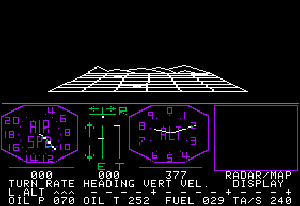
First generation (Apple II and TRS-80)
Computer-graphics specialist Bruce Artwick and pilot and marketing student Stu Moment were roommates at the University of Illinois. A2FS1 Flight Simulator, their first product after forming subLOGIC,[2] had black and white wireframe graphics, featured a very limited scenery consisting of 36 tiles (in a 6 by 6 pattern, which roughly equals a few hundred square kilometers), and provided a very basic simulation (with only one aircraft simulated). Despite this, it ended up being one of the most popular Apple II applications of the early 1980s.
The simulator was later ported to the TRS-80 Model I, which had only rudimentary graphics capability. To squeeze the simulator into the TRS-80 limited memory and display, subLOGIC saw it necessary to drop the instrument panel and reduce the resolution. Flight Simulator for the TRS-80 therefore has the most simplistic graphics of all versions of Flight Simulator (gameplay video in a modern emulator).
Later subLOGIC released updated versions of Flight Simulator for both the Apple II and TRS-80 on 51⁄4 inch diskettes. The updates included enhanced terrain, help menus, and a bomb sight.
Second generation (Tandy Color Computer 3, Apple II, Commodore 64, and Atari 800)
- - December 1983 for Apple II[2]
- - June 1984 for Commodore 64
- - October 1984 for Atari 800
- - Sometime in 1987 for CoCo 3
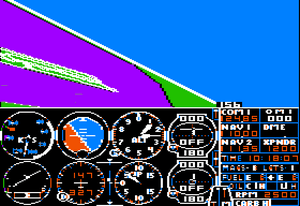
After the release of subLOGIC's Microsoft Flight Simulator for the IBM PC, subLOGIC backported its improvements to other computers as Flight Simulator II.[2] This version, like the Microsoft release, did away with wireframe graphics for solid colors, and featured real-world scenery (although limited to a few areas in the United States). It also introduced simulator add-ons, although not in the form it is today, as subLOGIC also included functionality to load additional scenery from floppy disks, thus making it possible for a user to virtually fly in his or her own backyard.
InfoWorld in 1984 praised Flight Simulator II for the Apple as "a complicated but exhilarating game ... Bruce Artwick has really done it all", and stated that it was superior to Microsoft's version.[3] II Computing listed it ninth on the magazine's list of top Apple II games as of late 1985, based on sales and market-share data,[4] and it was subLogic's best-selling Commodore game as of late 1987.[5]
Third generation (Amiga, Atari ST, and Macintosh)
- - March 1986 for Apple Macintosh[2]
- - November 1986 for Amiga and Atari ST
In 1984 Amiga Corporation asked Artwick to port Flight Simulator for its forthcoming computer, but Commodore's purchase of Amiga temporarily ended the relationship. SubLOGIC instead finished a Macintosh version, released by Microsoft, then resumed work on the Amiga and Atari ST versions.[2]
Although still called Flight Simulator II, the Amiga and Atari ST versions compare favorably with Microsoft Flight Simulator 3.0. Notable features included a windowing system allowing multiple simultaneous 3d views - including exterior views of the aircraft itself - and (on the Amiga and Atari ST) modem play.
Microsoft Flight Simulator
Flight Simulator 1.0

- - November 1982[2]
Sometime during 1981-82, Microsoft obtained the license to port the simulator to IBM compatibles PCs. This version was released in November 1982 as Microsoft Flight Simulator, and featured an improved graphics engine, variable weather and time of day, and a new coordinate system (used by all subsequent versions up to version 5).
Advertisements claimed "If flying your IBM PC got any more realistic, you'd need a license", and promised "a full-color, out-the-window flight display".[7] Early versions of Microsoft Flight Simulator were used as a test for PC compatibility. If a computer could run MSFS 1.0 and Lotus 1-2-3, it was 100% IBM PC-compatible, and if it could not, it was not.[8][9][10][11][12][13]
Compatibility difficulty included the unusual use of the x86 assembly DIV command, where a "DIVIDE BY ZERO" command would be issued every time a screen refresh was needed. This technique often required hardware changes to assure compatibility with MSFS 1.0 software.
There was a dogfight mode with the Sopwith Camel and crop-dusting mode included.
Flight Simulator 2.0
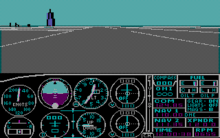
- - Released in 1984
In 1984, Microsoft released their version 2 for IBM PCs. This version didn't differ too much from MSFS1; the graphics were somewhat improved, as well as a more precise simulation in general had been created. The new simulator expanded the scenery coverage to include a model of the entire United States, although the airports were limited to the same areas as in MSFS1. However, compatibility with subLOGIC Scenery Disks was provided, which were released in the following years, gradually covering the whole USA, Hawaii, Japan, and part of Europe.
Flight Simulator 3.0

- - Released in mid-1988
Microsoft Flight Simulator 3 improved the flight experience by adding additional aircraft and airports to the simulated area found in MSFS2, as well as improved high-res (EGA) graphics, and other features lifted from the Amiga/ST versions.
The three simulated aircraft were the Gates Learjet 25, the Cessna Skylane, and the Sopwith Camel. Flight Simulator 3 also allowed the user to customize the display; multiple windows, each displaying one of several views, could be positioned and sized on the screen. The supported views included the instrument and control panel, a map view, and various external camera angles.
This version included a program to convert the old series of subLOGIC Scenery Disks into scenery files (known as SCN files), which could then be copied to the FS3 directory, allowing the user to expand the FS world.
Flight Simulator 4.0

- - Released in late 1989
Version 4 followed in 1989, and brought several improvements over MSFS3. These included amongst others; improved aircraft models, as well as an upgraded model of the Cessna Skylane, programmable dynamic scenery (non-interactive air and ground traffic on and near airports moving along static prerecorded paths). The basic version of FS4 was available for Macintosh computers in 1991. Like FS3, this version included an upgraded converter for the old subLOGIC Scenery Disks into SCN files.
A large series of add-on products were produced for FS4 between 1989 and 1993. First from Microsoft & the Bruce Artwick Organization (BAO) came the Aircraft and Scenery Designer (ASD) integration module. This allowed FS4 users to quite easily build, on the fly from directly within the program, custom scenery units known as SC1 files which could be used within FS4 and traded with other users (this activity was quite popular in the FS Forum on CompuServe). Also, ASD provided the addition of the Aircraft Designer Module. Again, from directly within the program the user could select one of two basic type aircraft frames (prop or jet) and proceed to parameter customizations ranging over 4 pages of flight envelope details and visual aspects. Finally, ASD provided additional aircraft including a B747 with a custom dash/cockpit (which required running in 640 × 350 resolution).
Next from Mallard Software and BAO came the sound, graphics, and aircraft Upgrade (SGA). This added digital and synth sound capability to FS4 (which previously was only via PC speaker.) Second a variety of high resolution modes became available for specific types of higher end video cards and chipsets, thus supplying running resolutions up to 800 × 600. As with ASD, the SGA upgrade also came with some additional aircraft designed by BAO, including an Ultra-light.
The final addition was known as the Aircraft Adventure Factory (AAF). AAF consisted of two primary components. First, the Aircraft Factory which was a Windows-based program allowing custom design aircraft shapes to be used within FS4 utilizing a unique, rather easy to use CAD type interface, supported by various sub menu and listing options. Once the shape was created and colors assigned to the various pieces, it could be tied to an existing saved flight model as was designed in the Aircraft Designer module. The end result was a two file unit, creating a new custom aircraft for FS4. Thousands of aircraft were designed by users using this utility and like scenery files, found their way onto the FS Forum at CompuServe (the Mecca for FS4). The Aircraft designed was an independent utility in terms of the flight simulator, and one didn't need to have it installed in order to use the aircraft files.
The other component of AAF was the Adventure module. Using a simple language (much similar to QBASIC), a user could design and compile a script that could be run from within FS4. Many FS4 parameters could be accessed including such things as aircraft position, airspeed, altitude, aircraft flight characteristics, etc. These could then be used to do things like display messages on the screen, play VOC audio files, and even display 256 color VGA images. The end result was that users could create fun adventures to use and share. The Adventure interface is integrated within an upgraded version of the sound driver from the previous SGA upgrade, and thus this driver is needed in order to play adventures. The adventure compiler itself is, however, a separate program. Two other minor utility drivers came shipped with the AAF, one that replaced the transponder digits with the actual framerate, and one that provided correct magnetic deviation within the US scenery map.
Other Add-On products (most published by Mallard Software) included: The Scenery Enhancement Edition (SEE4) which further enhanced SC1 files and allowed for AF objects to be used as static objects within SEE4. Pilots Power Tools (PPT) which greatly eased the management of the many aircraft and scenery files available. Finally, a variety of new primary scenery areas created by MicroScene, including Hawaii (MS-1), Tahiti (MS-2), Grand Canyon (MS-3), and Japan (MS-4). Scenery files produced by subLOGIC could also be used with FS4, including subLOGIC's final massive USA East and West scenery collections.
With its many options and add-ons, yet still relatively tight "in program" integration and overall ease of use, the FS4 suite of programs presented a type of VR Toolkit for users with a flight simulator slant. While complex in some aspects, FS4 environment building options (including scenery and aircraft design) would provide an unsurpassed access to these activities for average users; an option, which in later versions of FS, was much less available and increasingly complex.
Flight Simulator 5.0
- - Released in late 1993
FS5 is the first version of the series to use textures. This allowed FS5 to achieve a much higher degree of realism than the previous flat-shaded simulators. This also made all add-on scenery and aircraft for the previous versions obsolete, as they would look out of place.
The bundled scenery was expanded (now including parts of Europe). Improvements were made to the included aircraft models, the weather system's realism and artificial intelligence. The coordinate system introduced in FS1 was revamped, and the scenery format was migrated from the old SCN/SC1 to the new and more complex BGL format.
More noticeable improvements included the use of digital audio for sound effects, custom cockpits for each aircraft (previous versions had one cockpit that was slightly modified to fit various aircraft), and better graphics.
It took about a year for add-on developers to get to grips with the new engine, but when they did they were not only able to release scenery but also tools like Flightshop that made it feasible for users to design new objects.
Flight Simulator 5.1

- - Released in 1995
In 1995, Flight Simulator 5.1 was introduced, adding the ability to handle scenery libraries including wide use of satellite imagery, faster performance and a barrage of weather effects: storms, 3D clouds and fog became true-to-life elements in the Flight Simulator world. This edition was also the first version that was released on CD-ROM and the last for DOS. This was released in June 1995.
In the fall of 1995, with the release of the Flightshop program, nearly any aircraft could be built. The French program "Airport" was also available for free which allowed users to build airports (FS5.1 only had 250 Worldwide) and other designers were doing custom aircraft cockpit panels. This all made for a huge amount of "freeware" to be released to be downloaded and added to the FS5.1 simulator.
It was all finally coming together in late 1995 and into 1996—a much improved flight simulator, more powerful computers that were becoming affordable, the Internet for uploading/downloading, programs which allowed users to share their "third party" aircraft and scenery with others, and forums such as CompuServe, Avsim, and Flightsim.com to act as libraries for the uploads and discussion.
Flight Simulator for Windows 95

- - Released in mid-1996
As Windows 95 was released, a new version (6.0) was developed for that platform. Although this was more or less just a port from the DOS version (FS5.1), it did feature a vastly improved frame-rate, better haze, and additional aircraft, including the Extra 300 aerobatic aircraft. It also featured more 3-D detailing, this could be noticed in many places such as Manhattan, Meigs etc.
Instead of using the version number in the title, Microsoft instead called it "Flight Simulator for Windows 95" to advertise the change in operating system. It is often abbreviated as "FS95" or "FSW95".
This was the first version released after the purchase of BAO by Microsoft, and after having physically relocated development of the BAO development staff to Microsoft's primary campus in Redmond, Washington. The BAO team was integrated with other non-BAO Microsoft staff, such as project management, testing, and artwork.
Additional scenery included major airports outside Europe and the US for the first time.
Flight Simulator 98
- - Released in mid-1997
FS98 (6.1) is generally regarded as a "service release", offering minor improvements, with a few notable exceptions: The simulator now also featured a helicopter (the Bell 206BIII JetRanger), as well as a generally improved interface for adding additional aircraft, sceneries, and sounds. Other new "out of the box" aircraft included a revised Cessna 182 with a photorealistic instrument panel and updated flight model. The primary rationale for updating the 182 was Cessna's return to manufacturing that model in the late 1990s. The Learjet Model 45 business jet was also included, replacing the aging Lear 35 from earlier versions. The Dynamic Scenery models were also vastly improved. One of the most noticeable improvements in this version was the ability to have independent panels and sounds for every aircraft.
A major expansion of the in-box scenery was also included in this release, including approximately 45 detailed cities (many located outside the United States, some of which were previously included in separate scenery enhancement packs), as well as an increase in the modeled airports to over 3000 worldwide, compared with the approximately 300 in earlier versions. This major increase in scenery production was attributable partially to inclusion of the content from previous standalone scenery packs, as well as new contributions by MicroScene, a company in San Ramon, California who had developed several scenery expansions previously released by Microsoft.
This release also included support for the Microsoft Sidewinder Pro Force Feedback joystick, which allowed the player to receive some sensory input from simulated trim forces on the aircraft controls.
This was the first version to take advantage of 3D-graphic cards, through Microsoft's DirectX technology. With such combination of hardware and software, FS98 not only achieved better performance, but also implemented better haze/visibility effects, "virtual cockpit" views, texture filtering, and sunrise/sunset effects.
Flight Simulator 2000
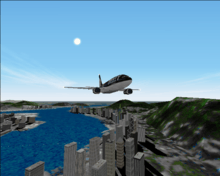
- - Released in late 1999
FS2000 (7.0) was released as a major improvement over the previous versions, and was also offered in two versions; one version for "normal" users, and one "pro" version with additional aircraft. Although many users had high expectations when this version arrived, many were disappointed when they found out that the simulator demanded high-end hardware; the minimum requirements were only a Pentium 166 MHz computer, although 400–500 MHz computer was deemed necessary to have an even framerate.[14] However, even on a high-end system, stuttering framerate was a problem, especially when performing sharp turns in graphically dense areas. Also, the visual damage effects introduced in FS5.0 were disabled, and continued to be unavailable in versions after FS2000. While the visual damage effects were still in the game, Microsoft disabled them from the game's configuration files. Users can re-enable the damage effects through modifications. FS2000 also introduced computer controlled aircraft in some airports.
This version also introduced 3D elevation, making it possible to adjust the elevation for the scenery grids, thus making most of the previous scenery obsolete (as it didn't support this feature). A GPS was also added, enabling an even more realistic operation of the simulator. FS2000 also upgraded its dynamic scenery, with more detailed models and AI that allowed aircraft to yield to other aircraft to avoid incursions while taxiing.
FS2000 included an improved weather system, which featured precipitation for the first time in the form of either snow or rain, as well as other new features such as the ability to download real-world weather.
New aircraft in FS2000 included the supersonic Aerospatiale-BAC Concorde (prominently featured on both editions' box covers) and the Boeing 777, which had recently entered service at the time.
An often overlooked, but highly significant milestone in Flight Simulator 2000, was the addition of over 17,000 new airports, for a total exceeding 20,000 worldwide, as well as worldwide navigational aid coverage. This greatly expanded the utility of the product in simulating long international flights as well as instrument-based flight relying on radio navigation aids. Some of these airports, along with additional objects such as radio towers and other "hazard" structures, were built from publicly available U.S. government databases. Others, particularly the larger commercial airports with detailed apron and taxiway structures, were built from detailed information in Jeppesen's proprietary database, one of the primary commercial suppliers of worldwide aviation navigation data.
In combination, these new data sources in Flight Simulator allowed the franchise to claim the inclusion of virtually every documented airport and navigational aid in the world, as well as allowing implementation of the new GPS feature. As was the case with FS98, scenery development using these new data sources in FS2000 was outsourced to MicroScene in San Ramon, working with the core development team at Microsoft.
Microsoft Flight Simulator 2000 was the last of the Flight Simulator series to support the Windows 95 and Windows NT 4.0 operating systems.
Flight Simulator 2002

- - Released in October 2001
FS2002 (8.0) improved vastly over previous versions. In addition to improved graphics, FS2002 introduced air traffic control (ATC) and artificial intelligence (AI) aircraft enabling users to fly alongside computer controlled aircraft and communicate with airports. An option for a target framerate was added, enabling a cap on the framerate to reduce stutter while performing texture loading and other maintenance tasks. In addition, aircraft feature a 3D virtual cockpit, creating in effect a view of the cockpit from the viewpoint of a real pilot. The external view also featured an inertia effect, inducing an illusion of movement in a realistic physical environment. The simulation runs smoother than Flight Simulator 2000, even on comparable hardware. A free copy of Fighter Ace 2 was also included with the software.
Anticipation was high for this version, because of its interactive AI traffic, ATC features, and its release shortly after September 2001. Due to the September 11 attacks, the launch was postponed to remove the twin towers of the World Trade Center in all copies, and the release date was pushed back to 19 October 2001.
Flight Simulator 2004: A Century of Flight
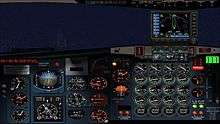
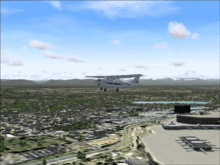
- - Released on 29 July 2003
Flight Simulator 2004 (9.0): A Century of Flight, also known as FS9 or FS2004, was shipped with several historical aircraft such as the Wright Flyer, Ford Tri-Motor, and the Douglas DC-3 to commemorate the 100th anniversary of the Wright Brothers' first flight. The program included an improved weather engine, that provided true three-dimensional clouds and true localized weather conditions for the first time.[15] The engine also allowed users to download weather information from actual weather stations, allowing the simulator to synchronize the weather with the real world. Other enhancements from the previous version included better ATC communications, GPS equipment, interactive virtual cockpits, and more variety in autogen such as barns, street lights, silos, etc.
A service update (9.1) was released on 10 June 2004, that included over 160 bridges missing or wrongly displayed in the original version, with several other corrections and performance improvements. As of 2015, FS2004 is still the most popular of Microsoft's simulators.[16]
Flight Simulator X

- - Released on 10 October 2006
Flight Simulator X (10.0), known as FSX, is the tenth and most recent edition in the Flight Simulator franchise. It features new aircraft, improved multiplayer support, including the ability for two players to fly a single plane, and players to occupy a control tower available in the Deluxe Edition, and improved scenery with higher resolution ground textures. FSX includes fewer aircraft than FS2004, but incorporates new aircraft such as the Airbus A321, Maule Orion, Boeing 737-800, and Bombardier CRJ700. The expansion pack, named Acceleration, was released later, which includes new missions, aircraft, and other updates. The Deluxe edition of Flight Simulator X includes the Software Development Kit (SDK), which contains an object placer, allowing the game's autogen and full scenery library to be used in missions or add-on scenery. Finally, the ability to operate the control surfaces of aircraft with the mouse was reintroduced after it was removed in FS2002.
Previous versions did not allow great circle navigation at latitudes higher than 60 degrees (North or South), and at around 75-80 degrees North/South it became impossible to "fly" closer to the poles, whichever compass heading was followed. This problem is solved in FSX. You may now navigate through any great circle as well as "fly" across both Arctic and Antarctic. This version also add's the option to have a transparent panel.
FSX is the first of the series to be released exclusively on DVD-ROM due to space constraints. This is also the first in the series that calls for the preparing process known as activating. Through the internet or a phone a hardware number is generated, and a corresponding code is then used to lock the DVD to one single computer only. It also requires a significantly more powerful computer to run smoothly, even on low graphical settings. Users have reported that the game is "CPU-bound" - a powerful processor is generally more helpful in increasing performance than a powerful graphics card.
This version removed Meigs Field from the game, as the actual airport was illegally destroyed one night by Chicago Mayor Richard Daley and no longer exists.[17] However, some Airports which have been decommissioned such as Kai Tak Airport in Hong Kong (which was closed in 1998, then abandoned for several years, and is currently being redeveloped for other purposes) still exists and is usable in FSX, with nothing lost in it. (This is possibly due to its world famous Runway 13 approach.) This is especially odd considering that Kai Tak was depicted close to its then-actual state in the three previous Flight Simulator versions.
Flight Simulator X: Acceleration
- - Released on 10 October 2007
Microsoft released their first expansion pack for Flight Simulator in years, called Flight Simulator X: Acceleration, to the US market on October 23, 2007 rated E – E10+ for mild violence, and released to the Australian market on November 1, 2007 rated G.[14] Acceleration introduces new features, including multiplayer air racing, new missions, and three all-new aircraft, the F/A-18A Hornet, EH-101 helicopter and the P-51D Mustang. In many product reviews, users complained of multiple bugs in the initial release of the pack. One of the bugs, that occurs only in the Standard Edition, is the Maule Air Orion aircraft used in the mission has missing gauges and other problems, as it is a Deluxe Version-only aircraft.
The new scenery enhancements cover Berlin, Istanbul, Cape Canaveral and the Edwards Air Force Base, providing high accuracy both in the underlying photo texture (60 cm/pixel) and in the detail given to the 3D objects.
Flight Simulator X: Acceleration can take advantage of Windows Vista, Windows 7, and DirectX 10 as well.
The expansion pack includes code from both service packs, thus installing them is unnecessary.
Microsoft Flight
- - Released on 29 February 2012
On August 17, 2010, Microsoft announced a new flight simulator, Microsoft Flight, designed to replace the Microsoft Flight Simulator series.[18] New to Flight is Games for Windows – Live integration, which means that the GameSpy client will not be used. An add-on market place was implemented as well, offering some additional scenery packs and aircraft as downloadable content (DLC). The new version was aimed at current flight simulator fans, as well as novice players. However, Flight has a different internal architecture and operational philosophy, and is not compatible with the previous Flight Simulator series.
Some users and critics such as Flying Magazine were disappointed with the product, the main issue being that the product is a game, rather than a simulator,[19] to attract a casual audience rather than enthusiasts who would want a more realistic experience.[20]
On July 25, 2012, Microsoft announced it had cancelled further development of Microsoft Flight, stating that this was part of "the natural ebb and flow" of application management. The company stated it will continue to support the community and offer Flight as a free download, but closed down all further development of the product on 26 July 2012.[21]
Lockheed Martin Prepar3D
In 2009, Lockheed Martin announced that they had negotiated with Microsoft to purchase the intellectual property and including source code for Microsoft ESP which was the commercial-use version of Flight Simulator X SP2. In 2010 Lockheed announced that the new product based upon the ESP source code would be called Prepar3D (pronounced "Prepared"). Lockheed has hired members of the original ACES Studios team to continue development of the product. Most Flight Simulator X addons as well as the default FSX aircraft work in Prepar3D without any adjustment since Prepar3D is kept backward compatible. The first version was released on 1 November 2010.
Dovetail Games
On the 9th of July 2014 Dovetail Games announced a licensing agreement with Microsoft to distribute Microsoft Flight Simulator X: Steam Edition[22] and to develop further products based on Microsoft's technology for the entertainment market. They announced plans to release a new flight game in 2015,[23] however their website has been updated to indicate this release would be sometime in 2016.[24]
Microsoft Flight Simulator X: Steam Edition was released on 18 December 2014, and is a re-release of FSX Gold Edition, which includes the Deluxe and Acceleration packs and both Service Packs. It includes "all standard Steam functionality", and replaces the GameSpy multiplayer system with Steam's multiplayer system.[25]
References
- 1 2 "Bruce Artwick is still flying". Flight Simulator History. 2001. Retrieved 21 February 2011.
- 1 2 3 4 5 6 Hockman, Daniel (April 1987). "Bruce Artwick's Flight Simulator / You've Come A Long Way, Baby! / The History of an Epic Program". Computer Gaming World. p. 32.
- ↑ Mace, Scott (1984-05-07). "In Praise of Classics". InfoWorld. p. 56. Retrieved 6 February 2015.
- ↑ Ciraolo, Michael (Oct–Nov 1985). "Top Software / A List of Favorites". II Computing. p. 51. Retrieved 28 January 2015.
- ↑ Ferrell, Keith (December 1987). "The Commodore Games That Live On And On". Compute's Gazette. pp. 18–22. Retrieved 24 January 2015.
- ↑ See King's Quest image for sample images
- ↑ Advertisement (December 1982). "If flying your IBM PC got any more realistic, you'd need a license.". PC Magazine. pp. Inside front cover. Retrieved 21 October 2013.
- ↑ Lockwood, Russ (September 1985). "Zenith Z-151; choice of U.S. Air Force and Navy". Creative Computing. p. 50. Retrieved 26 February 2013.
- ↑ Alsop, Stewart (31 January 1994). "A public Windows pane to make compatibility clearer". InfoWorld. p. 102. Retrieved 28 February 2011.
- ↑ Dvorak, John C. (12 May 1986). "Springtime In Atlanta Beats Fall In Las Vegas". InfoWorld. p. 66. Retrieved 28 February 2011.
- ↑ Satchell, Stephen (27 January 1986). "The Corona ATP Is Faster Than The IBM PC AT, But It Has Flaws". InfoWorld. pp. 47, 50. Retrieved 28 February 2011.
- ↑ Mace, Scott; Karen Sorensen (5 May 1986). "Amiga, Atari Ready PC Emulators". InfoWorld. p. 5. Retrieved 28 February 2011.
- ↑ Satchell, Stephen (14 January 1985). "AT&T 6300 PERSONAL COMPUTER". InfoWorld. pp. 49, 53–54. Retrieved 28 February 2011.
- ↑ Staff (1 November 1999). "Reviews: FS2000 Pro". FlightSim.Com. Archived from the original on 2006-12-13. Retrieved 21 February 2011.
- ↑ T. Byrl Baker (28 July 2003). "Microsoft Flight Simulator 2004: A Century of Flight Review for PC". GameSpot. Retrieved 21 February 2011.
- ↑ http://flyawaysimulation.com/downloads/fs2004/ "Because FS2004 is probably the most popular flight simulation package ever released,..."
- ↑ Paul Freeman (28 March 2009). "Illinois: Central Chicago area: Meigs Field (CGX), Chicago, IL". Abandoned & Little-Known Airfields. Retrieved 17 October 2010.
- ↑ Microsoft Flight
- ↑ http://www.flyingmag.com/flying-games/simulation-review-microsoft%E2%80%99s-flight-disappointment
- ↑ http://thenextweb.com/microsoft/2012/07/26/nosedive-microsoft-has-again-killed-off-its-flight-simulator/#!qxq91
- ↑ http://www.tomshardware.com/news/Microsoft-Flight-Simulator-Vancouver-MGS-games,16443.html
- ↑ http://venturebeat.com/2014/07/09/microsoft-flight-simulator-games-to-return-under-deal-with-dovetail-games/?utm_source=dlvr.it&utm_medium=twitter
- ↑ http://www.dovetailgames.com/news/2014/jul/9/dovetail-games-licensing-deal-with-microsoft-takes-flight
- ↑ http://www.dovetailgames.com/products
- ↑ "FSX Insider FAQs". FSX Insider. 2014-12-18. Retrieved 2014-12-18.
External links
- subLOGIC/Microsoft Flight Simulator history movie (2010) – Features all versions (185MB zip file)
- subLOGIC/Microsoft Flight Simulator history video (2006) – Features all versions up to FS2004 (280MB zip file)
- "Flight Simulator History" - Detailed history of early versions of Flight Simulator.
- "Microsoft Flight Simulator History Web" - Evolution of the Microsoft Flight Simulator.
- "FS4 Webport" - Extensive information and support for Microsoft Flight Simulator 4.
- "Lockheed Martin Prepar3D" - Prepar3D home page.